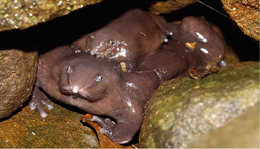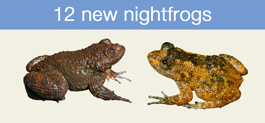Biju started his amphibian research in 1990 in the Western Ghats of India and gradually extended fieldwork to Northeastern India in early 2000. After establishing Systematics Lab in the University of Delhi in 2005, his team has done extensive field explorations throughout India to discover and conserve amphibians. Rich diversity, extraordinary endemism and shared evolutionary relationships with other biogeographical regions are some of the highlights of India.
|

|
Systematics
We believe that the current challenges in systematics are in describing species not yet described and correcting possible errors in current nomenclature (e.g. placement in a wrong genus). Our exploration for new species, began a decade ago, and is still continuing. Though we still use microscopes in our taxonomic work, we supplement it with other parameters such as molecular phylogenetics. We will soon bring out a comprehensive volume on Amphibians of India that will capture the science and spirit of our work. |

|
Reproductive ecology
Mate recognition mechanism is one of the driving forces for speciation. Studies in this field permit reconstruction of evolutionary stepping stones. Our recent research has shifted focus from the geographic context of speciation to the mechanisms that drive the evolution of reproductive isolation between populations. Advertisement calls and reproductive mode could be key factors that contribute to reproductive isolation. Our studies cover these aspects of amphibian behaviour too. Our findings from the Ghats have revealed novel reproductive modes. Evolution of amplexus and development is another focus area for our team. |

|
Conservation
About fifty percent of amphibian species in India is under various threat categories. Habitat loss and degradation are the leading causes of decline of amphibians in India. One of the largest impediments to conserving Indian amphibian fauna is the lack of correct identity and
incomplete information on distribution range. Currently we are working on the issue of species identification. We use IUCN criteria for conservation prioritization of individual species for proposing conservation measures. We have an initiative - www.wnpata.org, funded by CEPF and USFW, to identify and propose amphibian conservation areas. Lost Amphibians of India (LAI) www.lostspeciesindia.org is a national initiative, with headquarter at Systematics Lab, University of Delhi, to rediscover over 55 amphibian species, thought-to-be lost after their original description. |

|
Molecular Phylogeny & Biogeography
India is eminently suited for testing biogeographic hypothesis. The endemic amphibian fauna is rich and has likely evolved through complex interactions between geological and paleoclimatic events. Dispersal and vicariance have strongly influenced the formation of biogeographic patterns. Our current work includes morphological and molecular analyses of known/ new taxa and their closest relatives. The results could indicate geographical relations. This can be used to test hypothesis on historical biogeography.
|
|











